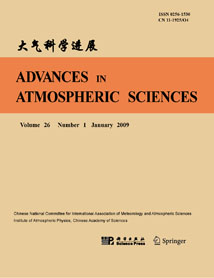| [1] |
YU Entao, WANG Tao, GAO Yongqi, and XIANG Weiling,
2014: Precipitation Pattern of the Mid-Holocene Simulated by a High-Resolution Regional Climate Model, ADVANCES IN ATMOSPHERIC SCIENCES, 31, 962-971.
doi: 10.1007/s00376-013-3178-9
|
| [2] |
SHI ChunE, DENG Xueliang, YANG Yuanjian, WU Biwen, ,
2014: Precipitation Chemistry and Corresponding Transport Patterns of Influencing Air Masses at Huangshan Mountain in East China, ADVANCES IN ATMOSPHERIC SCIENCES, 31, 1157-1166.
doi: 10.1007/s00376-014-3189-1
|
| [3] |
Yueyue LI, Li DAN, Jing PENG, Junbang WANG, Fuqiang YANG, Dongdong GAO, Xiujing YANG, Qiang YU,
2021: Response of Growing Season Gross Primary Production to El Niño in Different Phases of the Pacific Decadal Oscillation over Eastern China Based on Bayesian Model Averaging, ADVANCES IN ATMOSPHERIC SCIENCES, 38, 1580-1595.
doi: 10.1007/s00376-021-0265-1
|
| [4] |
Fei ZHENG, Shuai HU, Jiehua MA, Lin WANG, Kexin LI, Bo WU, Qing BAO, Jingbei PENG, Chaofan LI, Haifeng ZONG, Yao YAO, Baoqiang TIAN, Hong CHEN, Xianmei LANG, Fangxing FAN, Xiao DONG, Yanling ZHAN, Tao ZHU, Tianjun ZHOU, Jiang ZHU,
2024: Will the Globe Encounter the Warmest Winter after the Hottest Summer in 2023?, ADVANCES IN ATMOSPHERIC SCIENCES, 41, 581-586.
doi: 10.1007/s00376-023-3330-0
|
| [5] |
Long WEN, Kun ZHAO, Mengyao WANG, Guifu ZHANG,
2019: Seasonal Variations of Observed Raindrop Size Distribution in East China, ADVANCES IN ATMOSPHERIC SCIENCES, 36, 346-362.
doi: 10.1007/s00376-018-8107-5
|
| [6] |
Shuangmei MA, Congwen ZHU, Juan LIU,
2020: Combined Impacts of Warm Central Equatorial Pacific Sea Surface Temperatures and Anthropogenic Warming on the 2019 Severe Drought in East China, ADVANCES IN ATMOSPHERIC SCIENCES, 37, 1149-1163.
doi: 10.1007/s00376-020-0077-8
|
| [7] |
Bozhen LI, Gen ZHANG, Lingjun XIA, Ping KONG, Mingjin ZHAN, Rui SU,
2020: Spatial and Temporal Distributions of Atmospheric CO2 in East China Based on Data from Three Satellites, ADVANCES IN ATMOSPHERIC SCIENCES, 37, 1323-1337.
doi: 10.1007/s00376-020-0123-6
|
| [8] |
Long WEN, Wei ZHANG, Cha YANG, Gang CHEN, Yajun HU, Hao ZHANG,
2023: Near Homogeneous Microphysics of the Record-Breaking 2020 Summer Monsoon Rainfall during the Northward Migration over East China, ADVANCES IN ATMOSPHERIC SCIENCES, 40, 1783-1798.
doi: 10.1007/s00376-023-2242-3
|
| [9] |
ZHOU Xiaomin, LI Shuanglin, LUO Feifei, GAO Yongqi, Tore FUREVIK,
2015: Air-Sea Coupling Enhances the East Asian Winter Climate Response to the Atlantic Multidecadal Oscillation, ADVANCES IN ATMOSPHERIC SCIENCES, 32, 1647-1659.
doi: 10.1007/s00376-015-5030-x
|
| [10] |
CHEN Wen, ZHOU Qun,
2012: Modulation of the Arctic Oscillation and the East Asian Winter Climate Relationships by the 11-year Solar Cycle, ADVANCES IN ATMOSPHERIC SCIENCES, 29, 217-226.
doi: 10.1007/s00376-011-1095-3
|
| [11] |
HUANG Jianping, JI Mingxia, Kaz HIGUCHI, Amir SHABBAR,
2006: Temporal Structures of the North Atlantic Oscillation and Its Impact on the Regional Climate Variability, ADVANCES IN ATMOSPHERIC SCIENCES, 23, 23-32.
doi: 10.1007/s00376-006-0003-8
|
| [12] |
Liang Pingde, Liu Aixia,
1994: Winter Asia Jetstream and Seasonal Precipitation in East China, ADVANCES IN ATMOSPHERIC SCIENCES, 11, 311-318.
doi: 10.1007/BF02658150
|
| [13] |
Wu Bingyi, Wang Jia,
2002: Possible Impacts of Winter Arctic Oscillation on Siberian High, the East Asian Winter Monsoon and Sea-Ice Extent, ADVANCES IN ATMOSPHERIC SCIENCES, 19, 297-320.
doi: 10.1007/s00376-002-0024-x
|
| [14] |
Zhe HAN, Feifei LUO, Shuanglin LI, Yongqi GAO, Tore FUREVIK, Lea SVENDSEN,
2016: Simulation by CMIP5 Models of the Atlantic Multidecadal Oscillation and Its Climate Impacts, ADVANCES IN ATMOSPHERIC SCIENCES, 33, 1329-1342.
doi: 10.1007/s00376-016-5270-4
|
| [15] |
Zhu Jinhong, Wang Shaowu,
2001: 80a-Oscillation of Summer Rainfall over the East Part of China and East-Asian Summer Monsoon, ADVANCES IN ATMOSPHERIC SCIENCES, 18, 1043-1051.
doi: 10.1007/s00376-007-0024-y
|
| [16] |
Qian Weihong, Zhang Henian, Zhu Yafen, Dong-Kyou Lee,
2001: lnterannual and lnterdecadal Variability of East Asian Acas and Their Impact on Temperature of China in Winter Season for the Last Century, ADVANCES IN ATMOSPHERIC SCIENCES, 18, 511-523.
doi: 10.1007/s00376-001-0041-1
|
| [17] |
CHEN Shangfeng, CHEN Wen, WEI Ke,
2013: Recent Trends in Winter Temperature Extremes in Eastern China and their Relationship with the Arctic Oscillation and ENSO, ADVANCES IN ATMOSPHERIC SCIENCES, 30, 1712-1724.
doi: 10.1007/s00376-013-2296-8
|
| [18] |
Dabang JIANG, Dan HU, Zhiping TIAN, Xianmei LANG,
2020: Differences between CMIP6 and CMIP5 Models in Simulating Climate over China and the East Asian Monsoon, ADVANCES IN ATMOSPHERIC SCIENCES, 37, 1102-1118.
doi: 10.1007/s00376-020-2034-y
|
| [19] |
HUANG Ronghui, CHEN Jilong, HUANG Gang,
2007: Characteristics and Variations of the East Asian Monsoon System and Its Impacts on Climate Disasters in China, ADVANCES IN ATMOSPHERIC SCIENCES, 24, 993-1023.
doi: 10.1007/s00376-007-0993-x
|
| [20] |
LI Jianping, Julian X.L.WANG,
2003: A New North Atlantic Oscillation Index and Its Variability, ADVANCES IN ATMOSPHERIC SCIENCES, 20, 661-676.
doi: 10.1007/BF02915394
|















 AAS Website
AAS Website 
 AAS WeChat
AAS WeChat 
 DownLoad:
DownLoad: